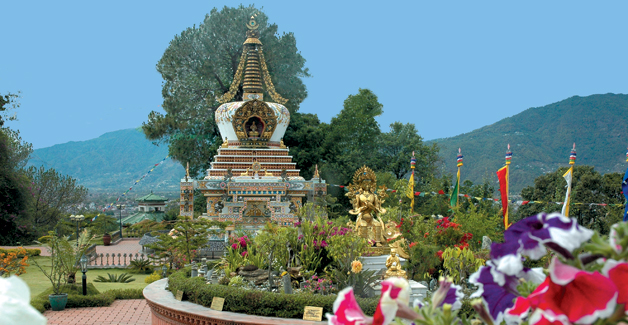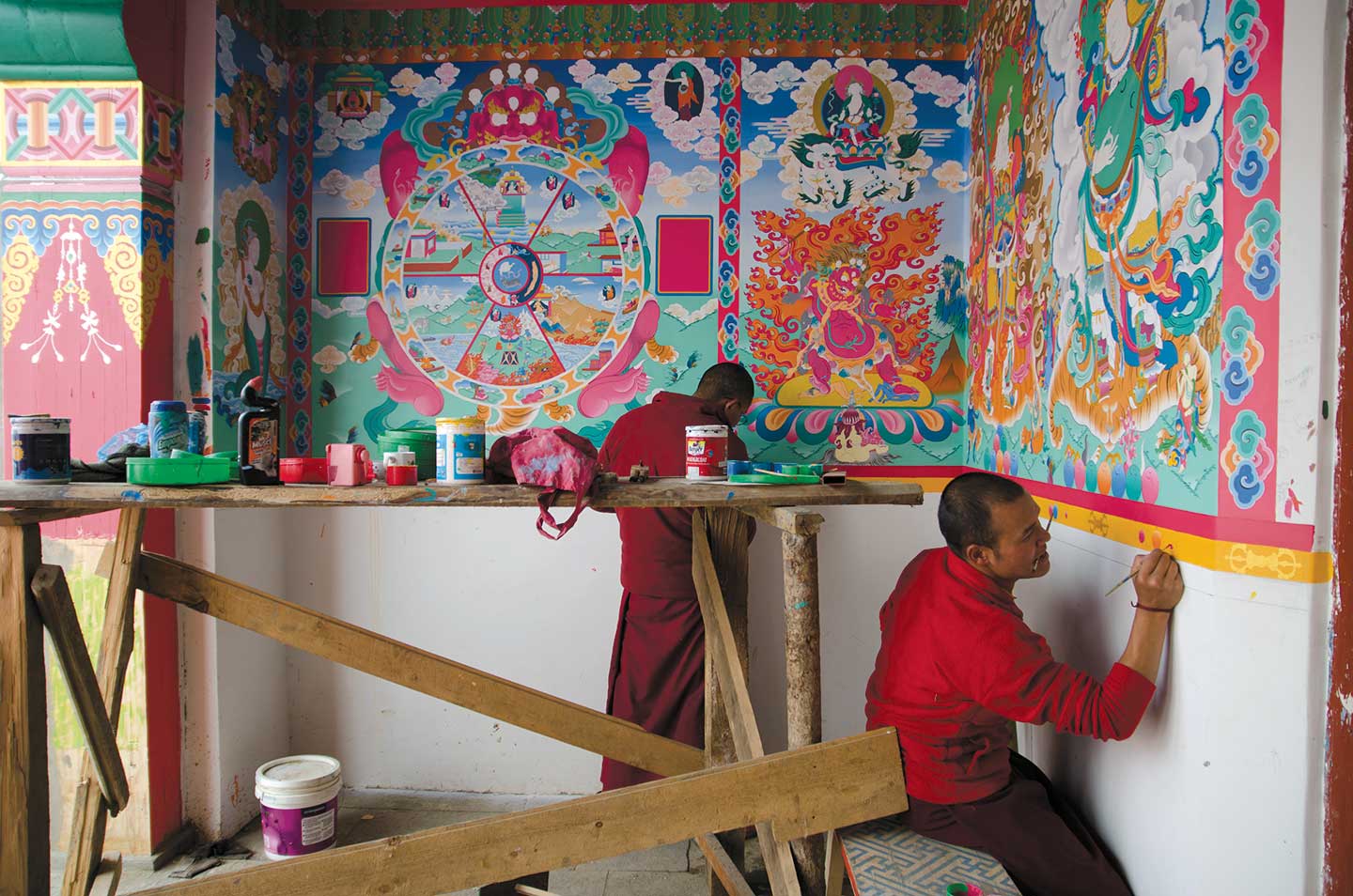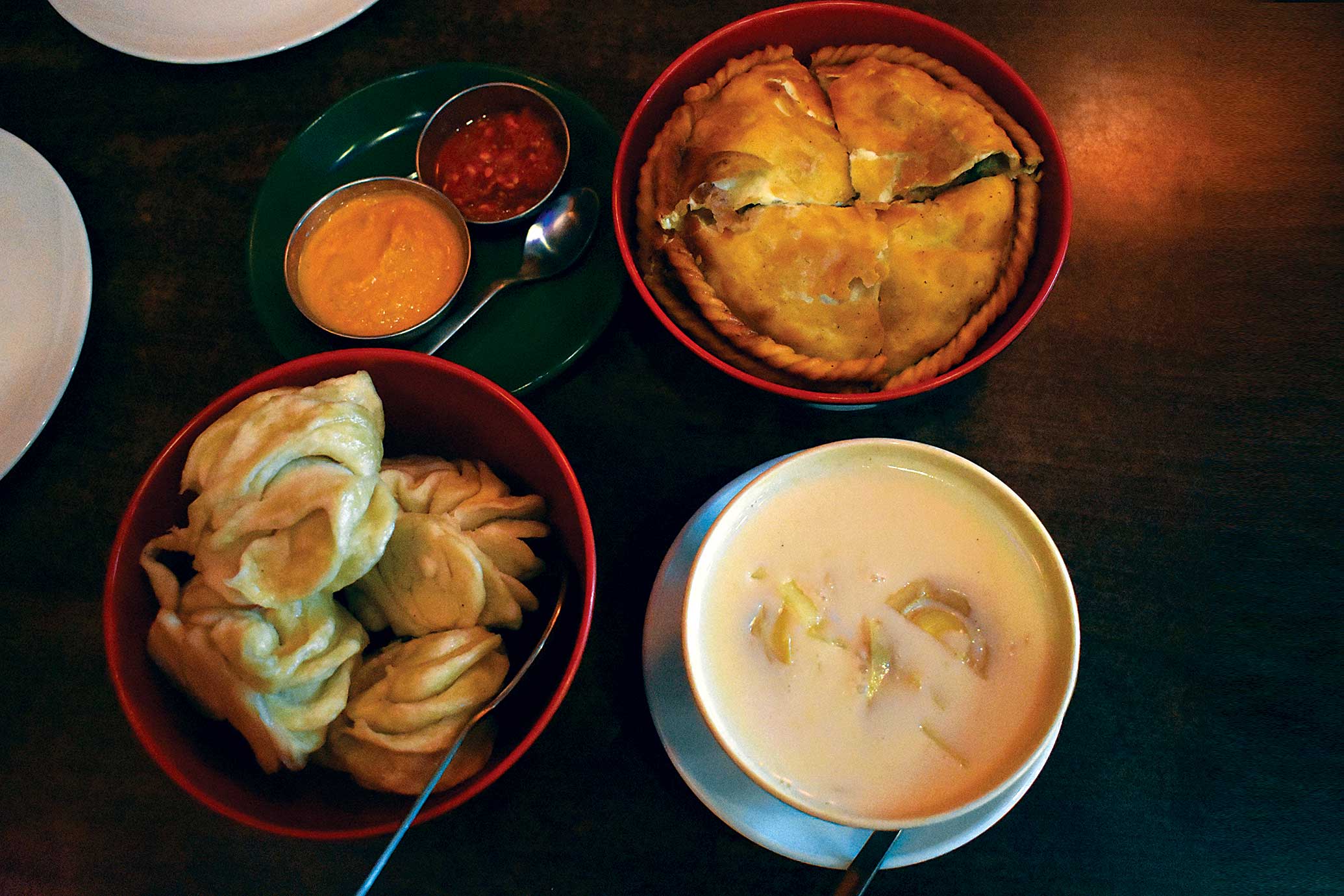Kopan was established by Lama Thubten Yeshe and Lama Zopa Rimpoche in 1970 as a center of Buddhist learning. It was inspired by the wish of many foreigners who were seeking spiritual guidance and a place to study Buddhism.

Ani Karin, a Swedish tourist came to Nepal in the 1970s while in her twenties. On one of her stops at Das Photo Stores in Khichhapokari where black & white films could be processed, she noticed a photograph of a beautiful thangka on the wall. Seeing her interest, Mr. Das told her of this very interesting monastery, where foreigners were taught Buddhist dharma and meditation. The thangka was from Kopan Monastery. Ani attended a course at the monastery and became a regular visitor and subsequently, decided to become a Buddhist nun. Today, Ani is a valuable asset to Kopan. “She is very important for foreign students, because she understands how we think and can perceive our difficulties,” says Alexander Koleszar, one of her students, “Her teachings are pure and clear,” he adds, full of admiration.
On my first visit to Kopan Monastery many years ago, I was fascinated by the row of bright yellow tents on the well-manicured grass. So I asked someone nearby, 'who sleeps in those tents?’ I was told that there was not enough room to accommodate all the foreigners who had come to attend classes. Some were here for a month long course, and in a normal year it was attended by 200 people. Since then, Kopan Monastery has grown and accommodation is no longer a problem. Perched on a hilltop, the monastery sits overlooking the city of Kathmandu. Indeed, the view from the café is unbelievable. It makes one wonder why nobody thought of opening a resort on this vantage point. If one looks around the valley, there has been a major proliferation of monasteries during the last decade and they now occupy the most enviable spots. The fact that thousands of Tibetans fled from Tibet and among them countless teachers of Buddhism, explains why there are so many monasteries coming up in the valley. Part of the reason is also the growing popularity of Buddhism in the west, particularly among the affluent, who have everything yet cannot find happiness.
Founding Fathers
Kopan was established by Lama Thubten Yeshe and Lama Zopa Rimpoche in 1970 as a center of Buddhist learning. It was inspired by the wish of many foreigners who were seeking spiritual guidance and a place to study Buddhism. The monastery follows the Gelug tradition of Tibetan Mahayana Buddhism and was also opened to provide young people of Solu Khumbu a place to study. Now there are 750 monks and nuns from the mountainous regions of Nepal, studying under the guidance of abbot, Khenrinpoche Lama Lhundrup. The mix of ethnic groups is surprising as many of the young student monks are Gurungs, Rais and Tamangs along with Sherpas, Tibetans, Mananges and others.
Good Reputation
The sound of young monks studying aloud greets us as we walk in. These days one needs special permission to enter, except on Saturdays and Sundays when visitors are allowed to enter from 2:00 pm to 4:00 pm. “Why the restrictions?” one might ask in surprise. After all it is a place of worship and people should have easy access. General Secretary, Lama Thupten Sherpa explains, “After we received some publicity through the media, we started getting the wrong kind of people. There were many who came here for entertainment and there were even young couples driving up like it was a resort. So you understand why we put curbs on visitors.” Lama Thupten is also reluctant to let journalists write about Kopan, afraid of attracting more revelers.
Kopan obviously enjoys a good reputation, as it attracts many foreign students. However, the recent escalation of unrest in the country has vastly depleted the number of visitors. Kopan is one of the monasteries that has been passing on the ancient traditions to the younger generation who will then pass on the vast knowledge that makes Tibetan Buddhism so popular the world over. Some of the foreign students who attended classes since the 1970s have gone on to establish Dharma centers in their own countries. Recently, I met a young couple from Belgium who came all the way to Nepal for the inauguration of a new monastery. They were studying Buddhism in their own country. Here in Kathmandu, a growing number of very young people are leaving their homes to become monks and nuns.
One of the founders of Kopan Monastery, Lama Zopa Rinpoche is the incarnation of the Lawudo Lama, a famous yogi from Solu Khumbu. This great lama had promised to give the children of Solu Khumbu a school and a monastery. It was Lama Zopa who arrived to fulfill this promise. They were later moved to Kathmandu and the establishment in Luwado became a retreat center and monastery-school for the local children. Lama Thubten Yeshe and Lama Zopa met in a refugee camp in Buxa, India and the latter became Lama Yeshe’s closest disciple. In 1967, the duo returned to Nepal and by 1970 had established Kopan and the Lawudo retreat center. Lama Yeshe passed away in 1984. Soon after his death, an interesting news item hit the headlines, which few people could have missed. It told the story of how a little Spanish boy had been recognized as the incarnation of a renowned Lama. Many may have read a book about the young boy. This was Lama Osel Rinpoche who is an incarnation of Lama Yeshe and presently studies at the Sera Monastery in South India.
Study Program
Kopan offers a complete study program to its student monks and nuns, many of whom will become qualified Dharma teachers. A new tantric college has been added to the facilities. Besides those who come here to study, there are many who serve the monastery and take care of the monks and nuns. The students also have a regular curriculum of Tibetan, Nepali, English and Geography etc. besides their dharma classes, which take precedence. Tantric studies include rituals and ceremonies, memorizing and chanting, creation of mandalas and consecration, which are related to the great sadhanas of Gujyasamaja, Heruka and Yamantaka. Then there are the painting classes. Buddhist religious paintings are highly refined and laden with symbolism.
Kopan has been well planned. The main monastery sits a little above the rest of the buildings and a place for meditation occupies the highest ground. At the monastery, it is interesting to watch the young monks in serious discussions. My first impression was completely off the mark, as I watched them slap their hands together and jump every now and then. “This must be some form of entertainment to tide away the boredom of monastic life,” I thought. How wrong I was. I was later to learn that this was part of the ritual of discussions among monks. The clap and jump is a means to stress a point and perhaps to draw attention from the listeners. Classes are held in the buildings nearest the gate. On the opposite side sits the store and café. The café is surprisingly good as well as spacious and serves great vegetarian food. Immediately opposite is the administration office with a library above. The library is well stocked with Buddhism books in English, German, Dutch and Spanish. There is also a large collection of Tibetan texts. An audio library holds recordings of teachings of many Tibetan lamas, including those of His Holiness Dalai Lama and Lama Zopa Rinpoche.
Courses, Rules & Facilities
Kopan has excellent facilities for accommodation with a choice of three-bed sharing, double room or single and dormitories. A large refectory serves the monks as well as the guests. The guests are directed not to bring radios, CD players, computers and musical instruments. No Pets are allowed in the compound either. Children can accompany their parents only when there are no courses. Courses are usually held in March, April, May, June, September and October and they give an introduction to Tibetan Buddhism and teach basic meditation skills. Ani Karin leads these classes and there are also daily teachings by a Tibetan Lama. Included in the course are sessions of meditation, daily group discussions as well as short retreats. The course leader also gives personal guidance if requested.
Kopan comes under the umbrella organization known as The Foundation for the Preservation of the Mahayana Tradition (FPMT), which has altogether 140 teaching and retreat centers, publishing houses, hospices and many other activities worldwide. The foundation was established in 1975 by Lama Yeshe, who was the spiritual head. After he passed away, his place was taken by Lama Zopa Rinpoche.
Inspired by Lama Zopa, the Kopan Nunnery came into existence in the early 1980s. The building work was completed in 1994 and now houses more than 380 nuns between the age of 8 and 50 years. This nunnery lies at the bottom of the hill below the Kopan Monastery.











